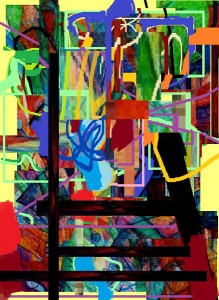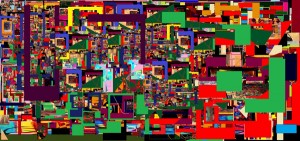Yehudis Barmatz:
I love the digital work. How does it inform or compare to the safrut? I am interested.
Wolk:
I am especially pleased that you love my digital work. Although I have had positive response to it, it seems that it is beyond many’s understanding; they don’t quite know how to begin to relate to it. There is a lot that can be spoken about it…Your question: How does it inform or compare to the safrut? is a very interesting question. I am not sure how to answer it, for such a question has not only never been raised, it has also not entered my mind a relation davka between the digital works and safrut. But since you raise the question, then, I say, certainly there is a special connection, and I will put some thought into it and try write for you a good answer. My experience with you tells me that you are asking on a very deep level; but if you could fill out for me the background of your question a bit, perhaps I could understand better what you see and what you are asking. Otherwise I will find what I find.
Barmatz:
I will give you a background to my question: In a presentation me and another student made last year about an essay by Joy Shaverain, who wrote a book called “the embodied image” on art and art therapy, we brought a number of examples of artist’s work to exemplify the use of language in combination with the use of art, how words do not replace art, nor vice versa, but rather work together, each playing an important role. I brought your work as an example, and my professor, an art lover and fan of calligraphy was greatly moved, finding your paintings to be very spiritually inspiring.
This reminds me of the conversation we had, how the visual influence of the paintings have a purpose of being spiritually moving, even to the bare eye. You also talked alot about intention as a part of the process, as one uses in Safrut. So there is calligraphy, intention, positive and negative space, spoken vs unspoken, spiritual subject matter (lettering).
Your digital pieces are a further step of processing the safrut. Your process is a constant self work on being able to break down words into its spiritual abstract presence so interpretation can become more a collaboration between artist and veiwer.
In the digital, the calligraphy aspect is being broken down built upon but not remade, because traditional safrut is done by hand.
Basically I just provided my own interpretation.
But how do you see the digital pieces, in context of the previous works.
Wolk:
Response on question of connection between Safrut and Digital Art.
I
-
Although my response may not appear, or not actually be, a direct reflection on your observations and understandings and analysis, please do not see this as any form of rejection of what you have understood or said. Rather I will approach the subject from the position of my own understanding of the subject in the present according to my need for expression of these subjects at this time–as an artwork, itself, which can only come out of the understanding of the artist at the time of his creation, whose form is fixed in terms of his need for expression of that understanding as it is for him at the time of creation. My understanding of all aspects of my artwork is always in flux; even though that there are certain foundations, nevertheless these foundations emanate in various directions and forms and take on various shapes and colors according to the other elements of understanding which are in flux.
-
Furthermore, neither the artist, or any other, knows except a small part of the true nature of his work and actions. The much greater part is very deep and hidden from the human mind in this world, (yet we do ‘sense’ at least some of the depth). Thus for a viewer to understand aspects of an artist’s work that the artist himself is not aware of is not in any way a mistake; for each person sees different aspects, according to their makeup; and, I believe, all the aspects are truly in the artwork, at least to some degree. Thus every reaction is important and contains an aspect of truth. [This is connected to that which you mentioned in your last letter concerning our discussion of this fact in my work—that it seeks to find completion in the viewer. I add now that this is a general principle in all art work, indeed in all human action. Yet it seems that perhaps my artwork promotes this aspect more. I don’t find myself able to discuss the depth of this issue here.]
II
-
-
Intent in safrut is at its most basic, the intent to preform the mitzvah as it is commanded. Additionally there must be intent to imbue the STAM (Sefer Torah, tefillin, mezuzah) with kedusha; that is, that it should be bound with the Source of Life, blessed is He, and not, Heaven forbid, a technical, physical act alone. At a deeper level, intention in safrut is a matter of connecting the thoughts and actions of the sofer below through specific channels to the Source of Life; the channels as they are mapped by tradition, namely the mekublim.
-
To be honest, my artwork has very great depth and scope, very much of which I cannot speak about, for various reasons. What I can reveal, some I will try to reveal here in short.
-
An artist is necessarily bound to expression of that which the eye sees. He is bound to the laws of color, form, balance, etc; therefore, his tools are also the gamut of art history; all of the ‘discoveries’ of all artists till his day. Therefore he must master not only the craft of seeing, rendering and organizing, but must also seek to understand and digest the gamut of others’ visions. Thus an artist is very much bound to this (physical) world.
-
The comparison to the sofer is that the sofer is also bound to the tools and techniques of his trade: ink, parchment, etc., and to the letters and to the halachot concerning them, which are the content and form of his work. Thus, also, he is bound in a particularly necessary aspect to this world. Yet the more that the sofer understands that the letters are spiritual, supernal forms, the more elevated is his work and the more kedusha they bring into this world.
-
An artist, also; the more that he grasps that the physical word is but clothing for the spiritual, the more elevated is his work and the greater is its potential for illuminating the spiritual of this world.
-
The attempt to create abstract works is the recognition of the metaphysical ; that that which underlies that which we see is a meta-order–underlying structure and rules, which delineate reality in a more profound way.
-
The abstract artist may rest in his exploration of the metaphysical at various levels that can be labeled “human wisdom”. Yet an artist can also understand the true Divine underlying order, which is and emanates from the Torah.
-
To me, it seems simple that for an artist who grasps the truth, that is: Torah, he will seek to express his art in relation to the shapes of the the Holy letters—which are the most visual conduits of Divine energy in this world.
-
III
-
-
In my understanding there is an perfect connection between all the laws and inventions in visual expression (art) with the letters of the Torah; through pictures based upon the letters of the Torah, all can find it’s fullest expression. This is simple. Art, for this artist, simply becomes an expression of Torah; of the living Torah which is in the artist, at all the levels of his grasp; peshat, remez, drash, sod. The artist who seeks to express Torah will find the visual language to do so, according to how much he labors at this.
-
The letters needn’t be explicit in the artwork. *{the letters themselves are clothings of Divine influx and there are levels of Divine influx which are higher that the letters. The letters and words of Torah at lower levels are expressed in the Luchot haBrit, Sifrei Torah, Holy sefarim, etc. At a lower level the letters of the Torah are enclothed in all of creation; mineral vegetable, etc. Thus art which is Torah needn’t be explicitly present as letters, for often many levels of clothing are often necessary.} Yet the artwork will have kedusha according to the degree and level that the artist is connected to the letters and words of the Torah in his process of creation of the artwork.
-
My works are almost exclusively informed by my inner concentration on different combinations of the Holy names of Hashem, as they are taught through the Kaballah, namely through the Ari Hakadosh. This is also very much related to what is brought in sefer Nefesh HaHiam from Rav Hiam Voloshiner, ztz”l and similarly in Amud HaTefilla of the Baal Shem Tov, HaKadosh; the matter of visualizing the letters and words of the tefilla; the letters being vessels of E-kut, the gateways of the human connection with the Divine. This is also brought in the first se’if of the Shulcan Aruch: the level of Tzaddikim who walk before Hashem to visualize the name of Hashem in front of themselves always. This process of visualization is at the core of my artwork, and indeed my whole life.
-
In truth it seems to me presently that there is not a fundamental difference between my digital works and paintings or drawings. Each is an expression of this devakus and occupation with Torah thought in terms of the particular medium in which I am working. Paint on canvas lends itself to certain forms and structures, pencil on paper to different forms, and the programs on photoshop and the basic workings of the computer and its technology to to other forms. I try to explore and develop language in each of these media in order to express the Torah that I have to express, to the best of my ability and understanding. To butter a piece of bread is also an artwork, and (can be) an act of yihud (unification) in it’s own particular form.
-
The purpose of my artwork is performing the rectifications which are upon me, the “unification of HaKadosh Baruch Hu and His Shechina” the “rising of the Shechina from the dust”, etc. as is the purpose of every Jew’s life. My success in this rides upon the various ascents and descents in my life.
featured image:
digital image:
Geula 2h, גמרא סנהדרין ק”ו ע”ב




